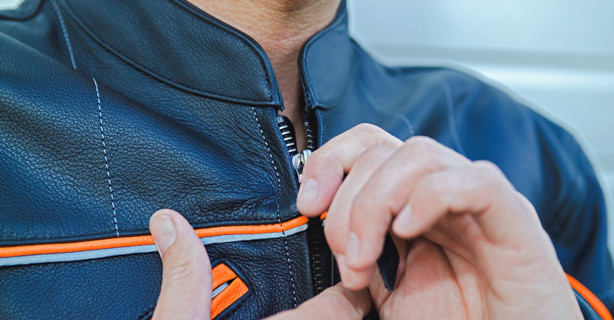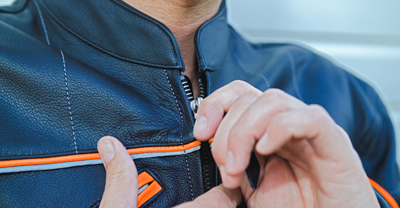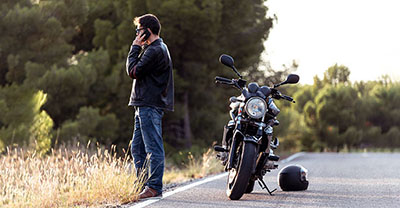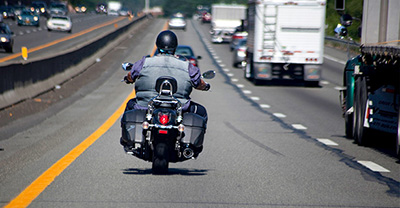An illustrated guide to motorcycle safety gear


0 min. read
If you’ve looked at motorcycle safety statistics lately, you’ll know that US motorcycle deaths are on the rise*. The alarming statistics highlight the importance of motorcycle safety gear. Properly wearing the right protective equipment can literally save your life and greatly decreases your chances of ending up in the hospital after a crash.
Head-to-toe motorcycle safety gear

Because motorcyclists lack the protection of a closed vehicle, wearing the right safety gear is absolutely critical for injury and fatality prevention in both riders and motorcycle passengers.
Take the first step to safe riding—know what to look for in the gear that can help protect you in a crash. Download your personal quick reference guide to motorcycle safety gear.
Motorcycle helmet

Wearing a helmet is the single most effective way to reduce head injuries and fatalities in the event of an accident on your bike. According to the CDC, motorcycle helmets reduce the risk of death by 37% for riders and 41% for motorcycle passengers.* Helmets also reduce the risk of head injury by a staggering 69%*. They are the difference between hospitalization and minor injuries in many accidents.
The right motorcycle helmet can also help fend off motorcycle-related hearing loss, a risk bikers often overlook until it’s too late. Helmets come in a variety of styles, so it’s important to find the one that works best for you. Your helmet should fit snugly to your head, be damage free, and be within the working life of a motorcycle helmet.
Motorcycle jacket

Riders wearing motorcycle jackets have a 21% reduced risk* of being hospitalized after a crash compared to those without jackets. The risk of hospitalization decreases even more when the jacket is armored.
The armored panels and impact-absorbing materials provide protection to the shoulders, elbows, back, and chest. This helps protect you from soft tissue injuries along with road rash, cuts, and bruises, which can lead to blood loss and infection.
Along with armor, your jacket can help you stay visible on the road. Look for options with reflective elements and bright colors that shine especially bright under headlights.
Motorcycle gloves

Impact-absorbing gloves can greatly reduce your risk of hand and wrist injuries. They provide protection from abrasions and help keep your hands and fingers safe in a fall. The palm and knuckle armor guards against bumps and impacts while the durable materials reduce road rash on your hands.
When choosing gloves, look for full finger coverage, wrist closures, and armor in the palm and knuckles for maximum protection. High-quality leather or textile motorcycle gloves generally stand up better to puncture, impact, or abrasion, lessening skin damage in minor spills.
Motorcycle pants

Armored motorcycle pants reduce the risk of hospitalization with leg and hip injury by 51%* compared to regular pants. This is important considering your legs are the most likely part of the body to be injured in a motorcycle crash and the least protected overall.
Armored bottoms protect the hips, knees, thighs, and tailbone during a slide. The knee armor absorbs impact in a collision, while the padded hips and tailbone areas cushion against hard bumps.
It’s important to look at materials and quality of construction when shopping for motorcycle pants. In the study referenced above, more than a quarter of pants suffered significant damage to the protective layer*, potentially exposing the rider to injury.
Leather or abrasion-resistant materials can help prevent painful road rash on the upper legs and seat. Wearing motorcycle pants may prevent a trip to the emergency room for the treatment of avoidable leg injuries.
Motorcycle boots

Research shows that while motorcycle boots can help reduce your injury risk, you don’t necessarily need boots specifically made for riding. It turns out, any sturdy boot will keep your feet, ankles, and legs significantly more protected than sneakers*.
Well-fitting boots help protect against ankle twisting, slips, and abrasions. Thick soles and steel shanks provide support and absorb vibration from the road. Reinforced toe boxes guard against breaking toes in a fall, while oil-resistant rubber soles maintain grip on slippery surfaces.
Look for boots with molded ankle protection cups that grip securely. Waterproof boots with insulation will help keep your feet warm and dry in inclement weather. For the best injury prevention, choose tall motorcycle boots that cover the shin and calf with abrasion panels. Not only do they cover more surface area, they’re more likely to stay on your feet in the event of a skid or fall.
The general information in this blog is for informational or entertainment purposes only. View our blog disclaimer.
*Data accuracy is subject to this article's publication date.










